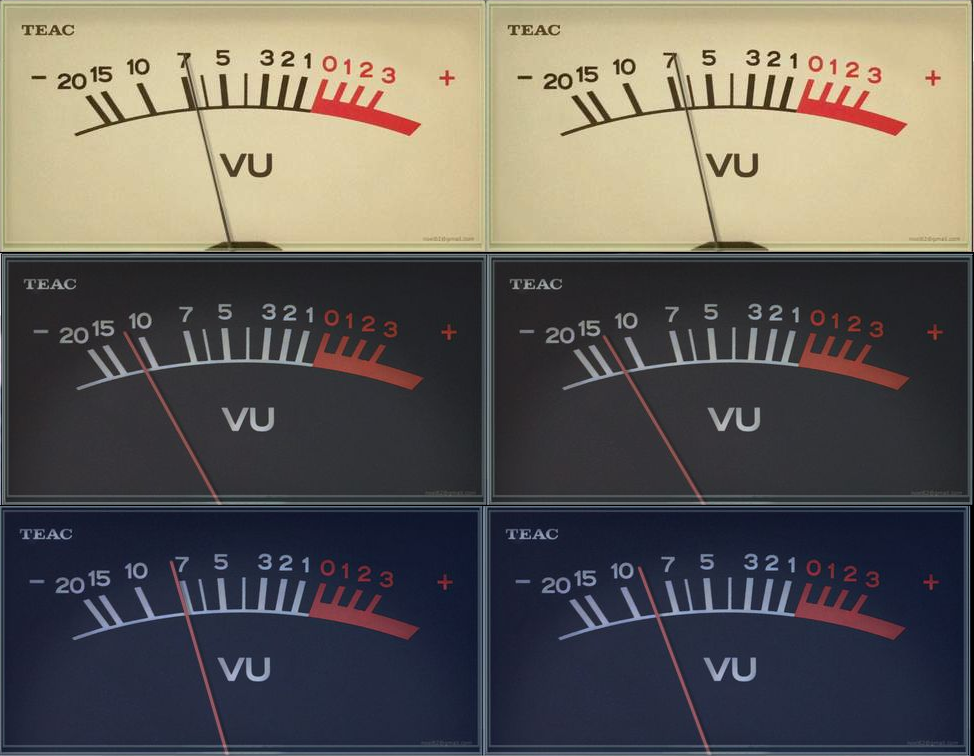


Don't forget to disable the layout editing mode when you're done.įurther customisation can be done by right-clicking the component and selecting some options. At this point one of the skins you have installed should start working. Select the "Analog VU Meter" from the list. Right-click the visualisation display area and select "Add New UI Element". Right-click the new tab and rename it to "Analog VU" or something else you like. Right-click the tab area in Visualisations panel and select "Add New Tab".
#Foobar analog vu meter skin
This skin requires 'foobar2000 Analog VU Meters' plugin which can be downloaded from: /forum/viewtopic.
#Foobar analog vu meter download zip
Installation instructions and recommended settings are included in the download zip archive. Select "View -> Layout -> Enable layout editing mode" from the menu. Custom-made hand-drawn meters art created specifically for your screen. Restart Foobar2000, so it can register the added dll. Place the desired skin (.bin) files in the Components folder. Place foo_vis_vumeter.dll in the Components folder. Select screen layout with Visualisations. Here's what I did (in particular check the bold part): Foobar 2000 VU Meter + Capa do disco + Lyrics - YouTube Personalização do Foobar 2000 inserindo capa do disco, Vu Meter analógico e letra da música.Customization of Foobar 2000 by. You might have to play a little bit with delay (in the VoiceMeeter settings list) to compensate for latency in case the VU Meter responds to early or to late to the audio signal.I just repeated the installation in portable mode and it works. (These virtual cables (as well as VoiceMeeter, and XMPlay of course) support KernelStreaming/WASAPI, ASIO, WDM and MME).ģ.
#Foobar analog vu meter install
Also, you might have to install additional virtual inputs/outputs (free, from VoiceMeeter guys) and use them to route the signal within your computer to be able to reach foobar, but play directly from XMPlay to your soundcard. It would be fantastic if someone would be able to create a plugin to make these VU meter. Depending on your sound card, ASIO might deliver better results than KS/WASAPI.Ģ. There are a lot of very nice VU meters for foobar2000, and they work really well and responsive. Once you start playback on XMPlay, VU Meter will respond to the audio being played.ġ. Start playback in foobar, to listen to the incoming signal.Īnd that's it.Add a new playlist, and add a location (File > Add location.) and type in record:// or record://60:00 (depending on your computer one of them will work).Set the output to Null Output (Preferences > Playback > Output).Install the foo_vis_vu_meter component, with a skin of your choice.

In XMPlay, point your output to VoiceMeeter Virtual Input (WASAPI is supported).Head over to Control Panel > Sounds > Recording devices, and set the default recording device to VoiceMeeter Virtual Output.Depending on your driver, you may use ASIO, KernelStreaming (WASAPI) or WDM (MME is least preferred). In VoiceMeeter, set the mixer output to your sound card.Designed for Microsoft Windows Vista and up (even. The large VU meters (the part) are pretty expensive. Windows VU Meter is a standalone application that mimics an old stereos VU or audio level meters. The secret is using VoiceMeeter, which is a virtual mixer, and foobar2000's foo_record plugin. They could use one of those vu-meter kit, put it in a nice box for me, add 80 margin, I would still buy it for 100-150 I am sure if they look cool. So, I actually managed to make that VU meter plugin work with XMPlay, using free software.


 0 kommentar(er)
0 kommentar(er)
